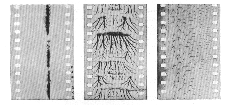
Static mark
A mark on processed film caused by the discharge of static electricity within or on the emulsion before processing. 1
Humidity has a great effect on the level of static electricity that can be produced as film is moved through equipment. Nitrate raw stock had a strong tendency to collect electrostatic charges during handling. Rolls of negative would often release these charges as they were unwinding in the camera and cause exposure of the film which results in lightning-like streaks after processing.
Motion picture directors were sometimes frustrated by static markings that appeared on the films. Acetate films were not entirely free from static troubles, but were much less troublesome than the nitrate.

To prevent the occurrence of static marks, direct friction-generating hand contact with low moisture content film, or rapid winding and unwinding of film in very dry conditions, should be avoided.
It is important to note that films stored under high humidity conditions or films that have been refrigerated and then opened immediately in warm environments will be subjected to possible adhesion problems. Such adhesion may result in static marks as the film is being used in cameras of film printers.
1 British Standard Glossary of Terms used in the Motion Picture Industry BS 5196:1975
The National Film and Sound Archive of Australia acknowledges Australia’s Aboriginal and Torres Strait Islander peoples as the Traditional Custodians of the land on which we work and live and gives respect to their Elders both past and present.


